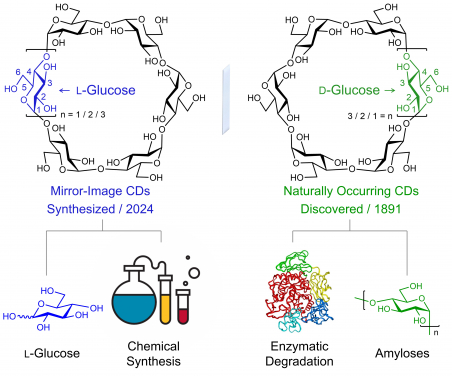Media
HKU Chemists Develop a Concise Approach to Access L-Cyclodextrins, Setting the Stage to Explore the Mirror-Image World of the Century-Old Naturally Occurring Cyclodextrins
24 Jun 2024
Cyclodextrins (CDs), a class of cyclic oligosaccharides that were “born” in 1891, have opened up endless research and commercial opportunities in numerous fields that span carbohydrate, supramolecular (host-guest) and analytical chemistry all the way from research laboratories in academia to the mass production of products—e.g., skin care enablers to drug delivery systems—in industry. Although they have been known for over 130 years, the most accessible cyclic homologues are α-, β-, and γ-CDs, which contain six, seven, and eight D-glucopyranosyl units, respectively. The odyssey of naturally occurring CDs suggests that despite the number of CDs is rather limited, their reach has been limitless.
For a long time, scientists (chemists, biologists, medical scientists, etc) have been exploring novel methods to synthesise—both chemically and enzymatically—CD homologues. These efforts include the syntheses of unusual smaller analogues with only 3, 4, and 5 D-glucose units and the making of rare larger CDs with 9 to 12 D-glucose units. All the currently available CDs are composed solely of D-glucopyranosyl units as the monomers, while the syntheses of mirror-image CDs have remained an untouched goal of the CD community, limiting the realisation of their full potential, such as in the development of new supramolecular sensors and catalysts, chiral materials, as well as innovative drug delivery systems and active pharmaceutical ingredients.
In order to fulfil this fundamental research niche, a collaborative research team led by Professor Sir Fraser STODDART in the Department of Chemistry of The University of Hong Kong (HKU) and Professor Daniel ARMSTRONG in the Department of Chemistry and Biochemistry of The University of Texas at Arlington, recently developed a concise approach to link L-glucopyranosyl monosaccharides together in a highly diastereoselective and scalable manner, resulting in the production of circa half-gram quantities of α-, β-, and γ-L-CDs. The availability of L-CDs for the first time—ever since the serendipitous discovery of their natural counterparts back in 1891—has enabled the elucidation of an unprecedented chiral self-sorting of a racemic modification of β-CDs in the solid state and an investigation of the chiral recognition of enantiomeric guests by α-L-CD in water. The research work was recently published and featured on the Cover in a leading scientific journal – Nature Synthesis. A corresponding News & Views Article written by Professor Sophie BEEREN, a cyclodextrin expert working at Technical University of Denmark, was also published in the same Journal (https://www.nature.com/articles/s44160-024-00512-w).
Innovative design
The team designed and synthesised two monosaccharide building blocks, both of which bear benzoyl groups as the source of protection of the primary hydroxyl groups, designated to direct the diastereoselective formation of 1,2-cis L-glucopyranosyl linkages through remote anchimeric assistance. In order to simplify the assembly process of linear oligosaccharides, monosaccharide and disaccharide building blocks were allowed to react sequentially in a one-pot manner, resulting in the rapid construction of linear hexa-, hepta-, and octasaccharides involving only minimal intermediate isolation and protecting group manipulation. The team carried out extensive optimisation of conditions for the intramolecular glycosylations (cyclisations) which ended up with the high-yielding formation of fully protected α-, β-, and γ-L-CDs. Final global deprotection produced the three L-CDs in up to eight steps from simple and readily available monosaccharide building blocks.
‘This piece of research, which showcases how synthetic carbohydrate chemistry can enrich the toolbox currently available for the CD community, constitutes a major milestone in the long history of CDs,’ commented Professor Sir Fraser Stoddart, ‘One fundamental question to be answered is that how the unnatural stereochemistry of L-CDs would affect those biomedically directed applications in which CDs are used as excipients in drug formulation and as active pharmaceutical ingredients?’ The team envisions that L-CDs should be more biologically stable than their natural counterparts on account of the fact that naturally occurring enzymes will not be able to recognise L-CDs. Currently, the team is collaborating with biomedical scientists to evaluate systematically the biological effects of L-CDs using different cell lines and animal models as well as to explore potential applications in biological and biomedical research.
About the research team
This research is a collaboration between Professor Sir Fraser Stoddart’s team in the Department of Chemistry (Faculty of Science, HKU) and Professor Daniel Armstrong’s team in the Department of Chemistry and Biochemistry (University of Texas at Arlington, United States). Research Assistant Professor Dr Yong WU from Professor Sir Fraser Stoddart’s team, who carried out the synthetic feat, is the first author of the research. Other HKU affiliated researchers, including Drs Han HAN, Chun TANG, Guangcheng WU, Huang WU, Ruihua ZHANG and Professor Aspen X.-Y. CHEN made contributions to this research project.
About the research paper: “Wu, Y., Aslani, S., Han, H., Tang, C., Wu, G., Li, X., Wu, H., Stern, C.L., Guo, Q.-H., Qiu, Y., Chen, A.X.-Y., Jiao, Y., Zhang, R., David, A.H.G., Armstrong, D.W., and Stoddart, J.F.* Mirror-image cyclodextrins. Nature Synthesis 2024, 3, 698−706.” The journal paper can be accessed from here: https://www.nature.com/articles/s44160-024-00495-8
For media enquiries, please contact Ms Casey To, Assistant Manager (Communications) (tel: 3917 4948; email: caseyto@hku.hk / Ms Cindy Chan, Assistant Director of Communications of HKU Faculty of Science (tel: 3917 5286; email: cindycst@hku.hk).
Images download and captions: https://www.scifac.hku.hk/press

